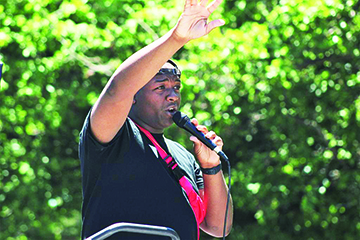
by Charles Bonniwell | Jul 23, 2021 | Main Articles
by Charles Bonniwell

More Trouble: The office of the Denver DA has opened a formal investigation into DPS Board Member Tay Anderson’s unlawfully soliciting and receiving gifts.
As reported in the May 2021 edition of the Glendale Cherry Creek Chronicle, a criminal complaint was filed on behalf of Campaign Integrity Watchdog by Matt Arnold. Arnold alleged that Anderson repeatedly violated C.R.S. Sec. 24-6-203 by soliciting and receiving, but not reporting, gifts totaling thousands of dollars. He did so through GoFundMe pages for everything from trips to Washington, D.C., to purported medical expenses from allegedly being pushed to the ground at the Colorado State Capitol during a protest. Anderson also solicited baby shower gifts on Target’s Baby Registry page.
After Anderson refused to answer intervention letters sent out to Anderson’s multiple addresses, Chief Deputy District Attorney at Denver DA, Joe Morales, reviewed the case again and assigned the case to Senior Criminal & Civil Investigator Kent Prose. In response, Anderson initiated an even more brazen scheme. He sent an email to his thousands of supporters declaring:

Campaign Integrity Watchdog had sent a similar complaint to the Colorado Secretary of State Jena Griswald, who dismissed the same, and Anderson had celebrated that dismissal in an April 29, 2021 email. At a July 14, 2021, press conference located at Brother Jeff’s Cultural Center, Anderson announced he was returning to his full schedule as a board member of Denver Public Schools (DPS) notwithstanding that the investigation into claims of 60 plus young women that he had allegedly sexually assaulted or harassed had not been completed.
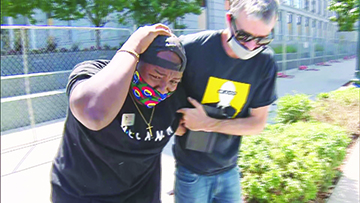
Capitol Incident: Anderson solicited gifts on a GoFundMe page for purported medical expenses stemming from allegedly being pushed to the ground at a protest at the state capitol on July 29, 2020.
DPS had appointed Investigations Law Group to look into all the claims against Anderson, including the one brought by Black Lives Matter 5280, and those referenced by Mary Katherine Brooks Fleming before the Colorado House Judiciary Committee on May 5, 2021.
Anderson claimed that the group had indicated that its investigation would take only 30 days but had taken longer. He also slammed the media indicating it was “complicit in the white supremacists’ attacks that have happened to my family.” He also asserted that he had contemplated suicide because of the hateful threats and comments.
The Denver District Attorney’s office has declined to indicate whether or not it has opened a separate investigation on Anderson regarding the claims of sexual assault and harassment.
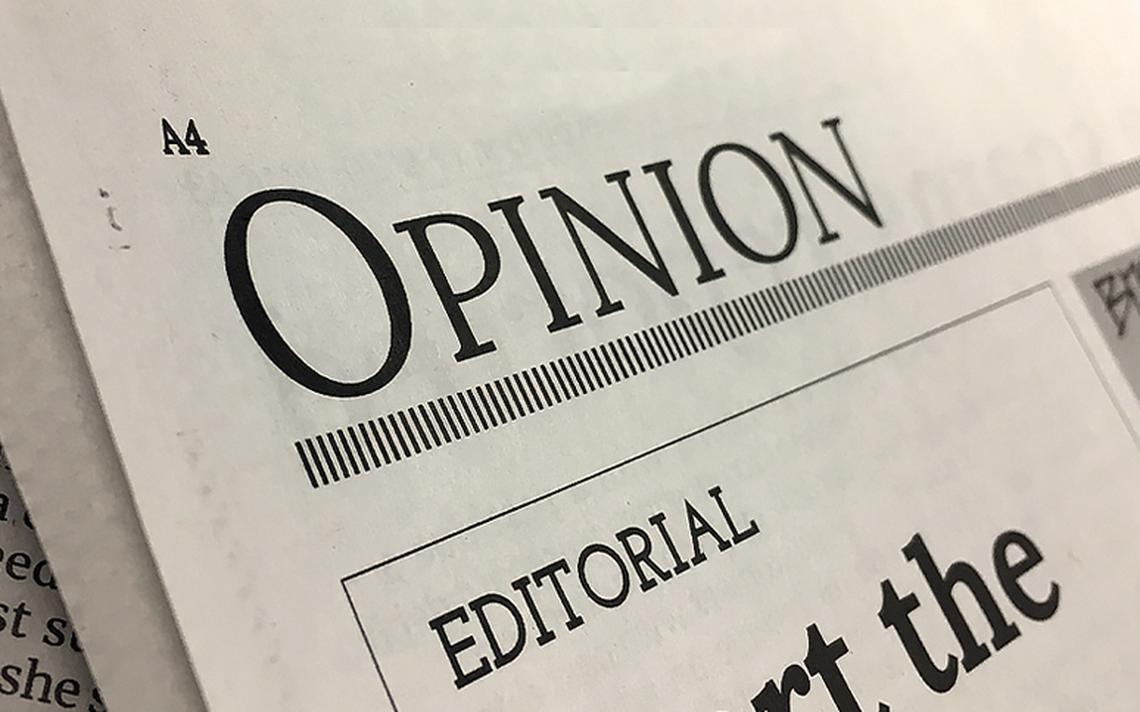
by Charles Bonniwell | Jun 25, 2021 | Editorials
If you enjoy only getting your news about local stories from the innocuous, politically correct viewpoint of today’s Denver Post you will be glad to know that may soon be essentially the only point of view available. The Denver Post was not always bland and politically correct and, in fact, it was just the opposite when it was owned and operated by two hustlers named Harry Tannen and Frederic Bonfils in 1895. The coverage was not exactly fair and balanced under their tutelage, but it was certainly sensational. It was an absolute must-read seven days a week.
Of course, not everyone enjoyed the coverage. One lawyer went to their offices and repeatedly shot both men. He was never convicted but Tannen and Bonfils were found to have jury tampered in the third trial. Another lawyer went to their offices and horsewhipped both men. A wonderful book on the glory days of the Post is Bill Hosokawa’s Thunder in the Rockies.
The paper did not get to its present emaciated state overnight, but it is now owned by a New York hedge fund, Alden Global Capital, that could care less about the content of the paper, and only cutting costs and squeezing every penny of profit possible.
A group of laid off reporters and editors started the digital Colorado Sun which, of course, reflects the viewpoint of the paper where they learned their craft. Now the Colorado Sun has a partnership with a new local non-profit, National Trust for Local Trust, has acquired 24 Denver metro newspapers including the 153-year-old Golden Transcript, as well as such other well-known local papers as Life on Capitol Hill, Washington Park Profile, Littleton Independent, and Englewood Herald.
Larry Ryckman, a former Denver Post editor and now editor-in-chief of the Colorado Sun told NPR that the “Colorado Sun . . . will drive [all 24] newspapers editorially” in what he and the other former Denver Post employees deem “the public good.” Oh, boy! We can’t wait for all 24 newspapers to be exactly the same editorially as the Colorado Sun and The Denver Post.
But wait you say? What about Colorado Politics and the Denver Gazette owned through a corporation by billionaire and Republican donor Phil Anschutz? Well, it appears that Mr. Anschutz believes that the only way to make money in the media business in this area is to mimic The Denver Post. So those sites, editor-at-large, Vince Bzdek, is a former Denver Post editor and its new managing editor, Linda Shipley, was, you guessed it, the managing editor for The Denver Post. Most of its reporters like Joey Bunch are also former Denver Post reporters.
The content of the Colorado Politics and Denver Gazette is basically identical to The Denver Post except for an occasional bland conservative op-ed or a puff piece on some has-been establishment Republican like Bob “Both Ways” Beauprez.
The homogenization of the news was recently highlighted when the annual Western Conservative Summit came back to town. Local self-identified communists and anarchist groups decided to have some fun punching out blue haired ladies, verbally harassing old men, and blocking downtown traffic. The Denver Post and its many offspring reported nothing as they know men and women of the Left only protest peacefully.
In the Denver market only Westword covered the mayhem having not yet been purchased by the Colorado Sun and its financing partner. Another independent paper The Villager appears to have survived the attempt to shut it down when its April Fool’s Day story was apparently not politically correct enough.
Below is a picture of the Western Conservative Summit outdoor festivities courtesy of the out-of-town news site, the Washington Times. There may come a time in the not-too-distant future where controversial stories will be covered, if at all, by only out-of-state news organizations.


by Charles Bonniwell | May 26, 2021 | Editorials
 Mark Twain famously said: “If voting made any difference, they wouldn’t let us do it.” His remarks certainly apply to Colorado today as the new Colorado Transportation Bill SB21-260 demonstrates. Colorado voters have repeatedly declared, since 1992 with the adoption of the Taxpayer Bill of Rights (“TABOR”), that they wanted to be able to vote on approving new tax increases. Similarly, Colorado taxpayers have repeatedly said that they do not want new taxes for roads. In fall of 2019, Proposition CC failed which would have allowed the state to keep the refunds that would have otherwise gone back to taxpayers under TABOR for roads. In the fall of 2020, voters turned down two Propositions, 109 and 110, which would have raised taxes for roads. In addition the voters approved Proposition 117, a measure requiring voter approval on fee hikes that generate more than $100 million in revenue over five years.
Mark Twain famously said: “If voting made any difference, they wouldn’t let us do it.” His remarks certainly apply to Colorado today as the new Colorado Transportation Bill SB21-260 demonstrates. Colorado voters have repeatedly declared, since 1992 with the adoption of the Taxpayer Bill of Rights (“TABOR”), that they wanted to be able to vote on approving new tax increases. Similarly, Colorado taxpayers have repeatedly said that they do not want new taxes for roads. In fall of 2019, Proposition CC failed which would have allowed the state to keep the refunds that would have otherwise gone back to taxpayers under TABOR for roads. In the fall of 2020, voters turned down two Propositions, 109 and 110, which would have raised taxes for roads. In addition the voters approved Proposition 117, a measure requiring voter approval on fee hikes that generate more than $100 million in revenue over five years.
None of it mattered in the least. Under SB21-260 the state legislature imposes an estimated $4 billion in new fees over 10 years for so-called transportation needs. That is an estimated $1,750 per household. How did they do it? Well, they divided the fees into four different enterprises, none of them individually exceeds the limit. One other fee, however, easily exceeded the limit, but they put that fee into a Highway Users Tax Fund, and since it is not an enterprise, it does not need voter approval.
One would think the Colorado courts would strike down such shenanigans, but we are assured by the conservative Independence Institute that the Colorado Supreme Court would find a way to approve the same. Given the black eye the Colorado judiciary has gotten from the discovery that the Judicial Department and Colorado’s former chief justice awarded a multimillion dollar contract to an employee to prevent her from disclosing incidents of workplace misconduct and sex discrimination, the courts might want the citizens to at least think they are not so biased that they can render impartial rulings, but apparently not.
The solution the Independence Institute gives us, is that ultimately the voters can punish those legislators who passed the legislation over the wishes of the voters. But in Colorado that has become a joke. Mail-in ballots and ballot harvesting in Denver make it impossible for anybody but a Democrat to win statewide office and assures a Democrat controlled State House and State Senate. That is why the State Legislature could care less what the voters want or do not want.
 There is at least a silver lining in all of this. Voters have indicated that they do not want new taxes or new fees used to build and repair roads and bridges, and under SB21-260 very little of the money will be used for that. It is estimated the roads and bridges will be involved in only 17% to 18% of the spending and rest used for subsidies for electric cars and multimodal transportation. So, after a flurry of spending the roads in Colorado will remain highly congested and in poor repair. Nothing will change except the lightening of the public pockets.
There is at least a silver lining in all of this. Voters have indicated that they do not want new taxes or new fees used to build and repair roads and bridges, and under SB21-260 very little of the money will be used for that. It is estimated the roads and bridges will be involved in only 17% to 18% of the spending and rest used for subsidies for electric cars and multimodal transportation. So, after a flurry of spending the roads in Colorado will remain highly congested and in poor repair. Nothing will change except the lightening of the public pockets.
You could, of course, call your duly elected state representative/senator but many of them are not even bothering these days to take such calls or read constituent mail. Why should they? In case you have not figured it out yet, you don’t live in a democratic republic in Colorado, but an interesting form of an oligarchy. You can have fun voting, relieved of any burden that your vote, as Mark Twain noted, “makes any difference.”
— Editorial Board

by Charles Bonniwell | Apr 23, 2021 | Editorials

Kyle Clark, 9NEWS superstar, is beginning to feel the vultures circling.
At one time, not that long ago, KUSA 9News was a powerhouse in the Denver media market with massive ratings and was lovingly called the “Mommy Channel” for its popularity with female viewers. But it seems all good things must come to end. Things started “Breaking Bad” when Kyle Clark floated into town from New York in 2007.
Over the years, the acerbic New Yorker eventually came to dominate 9NEWS and is literally almost impossible to escape if you tune into Channel 9. He hosts “Next with Kyle Clark” at 9 p.m. on weekdays, and if that is not enough, he is the news anchor for 9NEWS on its 10 p.m. broadcast. He also contributes reports for 9NEWS political coverage, the 9Wants to Know Investigative unit, and 9NEWS Storytellers. He is perhaps best known for getting into endless Twitter wars with scores of individuals across the Front Range.

Murder by 9News security guard Matthew Dolloff of Lee Keltner at pro police rally on October 10, 2020.
While 9NEWS ratings are beginning to take a dive, in an age where objective television news is considered passé, he gained admirers by putting his leftwing progressive views into all of his reporting. One never needs to wonder what his personal views are as it relates to any story. The bias reporting was clearly fine with KUSA Channel 9 parent company, the giant publicly traded media company TEGNA, Inc.

Lori Lizarraga
In recent times, however, the wheels appear to be coming off the once all-powerful media vehicle. In June 2020, Clark was furloughed by TEGNA as part of a company-wide cost saving strategy. Reporters for 9NEWS started to become so disliked by some the station began hiring armed security guards when they went to events.
Through a third party they engaged an unlicensed security guard, Matthew Dolloff, who shot and killed grandfather and military veteran Lee Keltner at a pro police rally in front of his son on October 10, 2020. Kyle Clark went into hiding with a security detail claiming he was taking an unannounced vacation. 9NEWS boarded up its windows and kept the staff at home for an extended COVID period. Dolloff was charged with 2nd degree murder by the Denver DA, and the Keltner family hired an attorney for possible legal action against Channel 9 and TEGNA.

Sonia Gutierrez
In March of this year Clark’s and 9NEWS’ reputation as being progressive took a tremendous hit. Lori Lizarraga wrote a scathing article in Westword: “LatinXed: 9News Got Rid of Three Latina Reporters This Past Year, Including Me,” detailing a pattern and practice of discrimination at the news station. In addition, one of TEGNA’s largest shareholders demanded that the company open its books and records to investigate what is being called a broad pattern of bias and racially insensitive behavior.
The investor stated that the allegations show “the roots of racist behavior within Tegna/Gannett are ugly and run deep” and are reflected in “egregious practices with Tegna/Gannett dating back decades.”

Kristen Aguirre
Gannett previously owned the broadcast business that is now stand alone TEGNA. TEGNA spun off the publishing business as Gannett in 2015.
And, of course, Kyle Clark went on an immediate unannounced vacation.
Perhaps Mr. Clark, TEGNA, and 9NEWS, and their phony “wokeness,” might just like to leave town and sell the station to some entity who would like to bring the station back to what it once was.

by Charles Bonniwell | Mar 19, 2021 | Editorials
When Amanda Sandoval and Amanda Sawyer were elected to the Denver City Council, from District 1 and District 5 respectively, this Editorial Board could not have been more thrilled. We strongly endorsed both candidates as women who would take strong stands against Mayor Hancock when appropriate. Sawyer upset incumbent Mary Beth Susman, who had decided to become little more than a shill for Hancock and his developer buddies. Sandoval, on the other hand, had been the aide to former Councilmember Rafael Espinoza, arguably the best councilman in the previous Council term. But he decided he could be more effective on the outside rather than in government and would be there to help, and assist Sandoval, when needed.
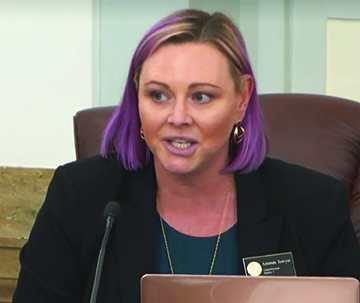
District 5 Denver City Councilwoman Amanda Sawyer
As far as opposing Hancock when needed each has done an outstanding job. But as for being decent human beings each has been an abysmal failure. Lord Acton the famous 19th century historian said: “All power tends to corrupt, and absolute power corrupts absolutely.” He noted that such people are not innately evil. They begin as decent human beings but soon evolve.
We have watched Denver City Council members come and go for decades now. It is an interesting process to observe. Many were relatively powerless prior to coming to office and that certainly was the case with the Amandas. Sandoval came from a highly political family but was known for her kindness and appreciation for others. Sawyer had lots of degrees, both a JD and an MBA. She had moved to Hilltop with her husband to raise their five children and had no political background. With the help of the EMERGE program, which trains Democratic women for political office, she prevailed.
It didn’t take either one very long to begin attacking and denigrating anyone who got in their way. For both, they always asserted that they were being “bullied” when they were, in fact, the biggest bullies. Sawyer claims any opposition to her is “sexist,” and Sandoval quickly claims everything is “racist.”
At times Sandoval appears to represent only the Latinx community. When Sandoval spearheaded the change of the name of Columbus Park to La Raza Park (which means The Race Park) she seemed clueless on why African Americans seemed to wonder whether they were welcome at the park. Her relations with the black community took a deep dive when she was booed at a City Council meeting after stating: “I support a lot of things that are going on. But it’s the same violence that is happening in our community. It’s Black on Black. It’s brown on brown.”
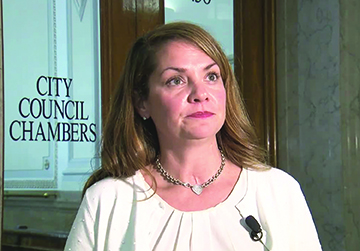
District 1 Denver City Councilwoman Amanda Sandoval
The black community began a “Recall Sandoval” campaign. She claimed she and her entire family were being threatened by something called the Afro Liberation Front and she went tribal. She asserted the Chicanos who had gone before her had been afraid, at times, but always showed up. She asked her supporters to take over the streets of North Denver. While everything eventually calmed down, starting race wars in District 1 was not previously thought to be one of the functions of a Denver City Councilmember.
If anything, Amanda Sawyer has been worse. She decided to try to destroy the career of an employee at the Denver Department of Transportation and Infrastructure (DOTI). She threatened to block every DOTI bill and grind the department into the ground unless she was given her way. When the employee responded in his defense, she declared it was sexist and claimed people were trying to smear her. She and her attorney wrote extremely unprofessional letters, claiming false and sexist attacks and threatening to file legal actions. A spokesperson for Hancock responded: “As far as I know there is no precedent for a member of city council, or any public servant, to communicate with the Mayor’s office this way.” Leave it to Amanda Sawyer to accomplish the impossible of making Mayor Hancock look sympathetic.
The Chronicle’s reporter Robert Davis recently had a chance to experience the full Amandas treatment. In a story on page 15 of the March 2021 edition of the Chronicle, he incorrectly indicated that Amanda Sandoval voted against the Group Living Amendment when it was, in fact, Amanda Sawyer. No apologies were enough for the Amandas. When alerted on Sunday morning, February 28, 2021, The Chronicle’s Executive Editor immediately changed the online version and updated the photo used in the story. This was also not sufficient. Nor was the declaration that a correction would be placed in this month’s printed edition (see Correction below).
If you believe them, Mr. Davis was clearly a misogynist. Amanda Sawyer immediately posted on Twitter where she joined Denver School Board Director Tay Anderson in attacking the paper. Separately, she has claimed that the Chronicle is out to get her, even though she has received overwhelmingly positive coverage from this paper since assuming office.
As a practical matter, newspapers from the Chronicle to The New York Times make inadvertent errors, and all papers can do is acknowledge the mistakes and move forward. As for the Amandas, we have had it with them. We will continue to report on them fairly. But like many people and businesses in Districts 1 and 5, Amanda Sandoval and Amanda Sawyer have lost all goodwill and this newspaper will not hesitate to defend and protect those people they unfairly and viciously attack. You can oppose Mayor Hancock without being total jerks, notwithstanding what Amanda Sandoval and Amanda Sawyer think.
Correction
In the March 2021 edition, on page 15, the Glendale Cherry Creek Chronicle printed a story titled “Denver Approves Controversial Group Living Amendment.” Within the story, we mistakenly identified Councilmember Amanda Sandoval voting against the amendment when in fact it was Councilmember Amanda Sawyer who voted against it. We regret the error.















